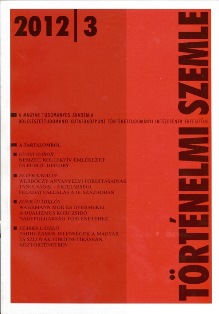Párhuzamos jelenségek a magyar és szlovák történetírásban, köztörténetben
Parallel Phenomena in Hungarian and Slovak Historiography and Public History
Author(s): László SzarkaSubject(s): History
Published by: Magyar Tudományos Akadémia Bölcsészettudományi Kutatóközpont Történettudományi Intézet
Summary/Abstract: The present study examines the problems which were raised by Roman Holec in his Trianon rituals or considerations of some features of Hungarian historiography (Historický Øasopis 59. [2011] Supplement 25–48.) and partly by Csaba Zahorán in his polemic article which was published in Történelmi Szemle 2011/4, with a look to the history of Hungarian–Slovak historiographical polemics in general. Since 1989 considerable changes have taken place in both Hungarian and Slovak historiography, one of the most important consequences of which is that the professional – academic and university – view of history has become greatly differentiated. The negative side of this process with regard to Slovak historiography was already critically examined by Roman Holec in his articles published previously; the study of his which is the object of the present debate focuses on the seamy aspect of the process on the Hungarian side only. An especially important topic to discuss can be the rearrangement of the research and education of history in Central Europe which can be observed in the field of public history. The concise histories of varying professional niveau, political commemorations and sensational “discoveries” all offer useful topics to both politicians and the media, since they express their own ideological prefigurations and programs through histories of their own as opposed to “official history”. The study pays attention to the fact that the Hungarian–Slovak Historical Committee has already dealt several times with those common questions and problems of interpretation which are emphatically referred to in the study of Roman Holec. The author indicates that in judging the process of assimilation which became a mass phenomenon during the Austro-Hungarian dualism, not all the changes of language and identity which characterised different social groups, geographical regions or cities can be blamed exclusively on the nationalism of the contemporary Hungarian state. It is in this context that the author challenges the contention of Holec that the Hungarian society is “history-sick”. The reasons for abusing history are frequently to be looked for outside the historical profession itself, and the solutions lay in the framework of the politics of history. Holec includes in his selection of Hungarian ethno-centric Trianon interpretations authors who examined the context in which the Central-European nation states had been born between 1918 and 1920 with sufficient circumspection and with due regard to the problem’s complexity, and whose criticism in this context is consequently unjustifiable. The study draws attention to the fact that a part of Slovak historiography and public history are characterised by the same manifestations of one-sidedness as their Hungarian counterparts. It is thus important that anyone criticising ethno-centric phenomena should also engage in a comparative analysis of competing historiographies.
Journal: Történelmi Szemle
- Issue Year: 2012
- Issue No: 03
- Page Range: 469-490
- Page Count: 22
- Language: Hungarian

